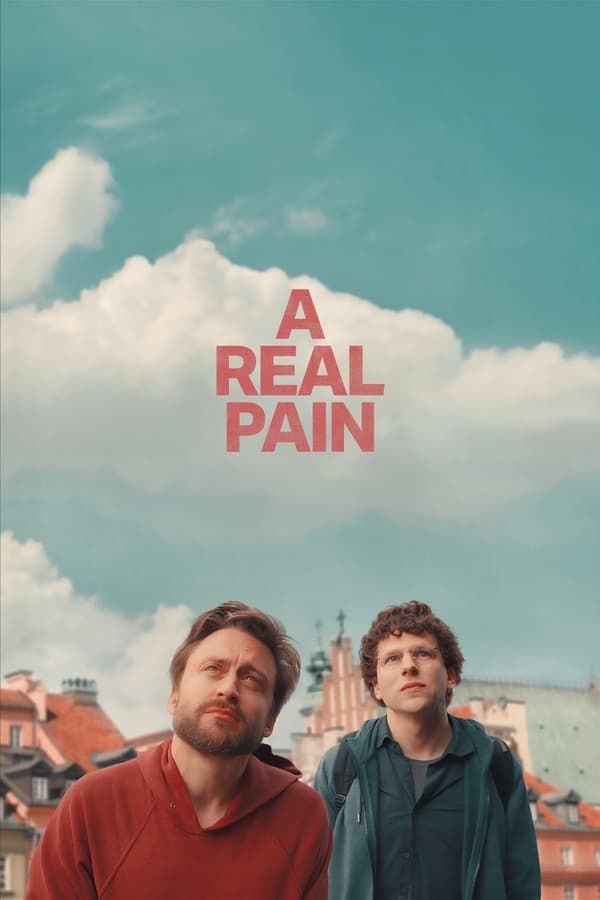[ad_1]
dolor realLa fecha de lanzamiento de la imagen real se confirmó luego de la victoria de Kieran Culkin en el Globo de Oro. Con el telón de fondo de la Polonia contemporánea, la comedia dramática de 2024, dirigida por Jesse Eisenberg, sigue a los primos no coincidentes David (Eisenberg) y Benji (Culkin) mientras se embarcan en una aventura para honrar a su abuela recientemente fallecida y explorar sus vidas. . Historia familiar. Desde su lanzamiento el 1 de noviembre. dolor real Recibió críticas entusiastas de la crítica y el público, y recibió premios, especialmente por la interpretación de Culkin como el encantador pero emocionalmente problemático Benjy.
dolor real viniendo a Plataforma de streaming Hulu el 16 de enero. Los suscriptores de Disney+ que tengan el complemento Hulu también podrán transmitir la película en la plataforma Disney+. La película fue nominada recientemente a los Globos de Oro 2025 en cuatro categorías, incluyendo Mejor Película, Mejor Actor para Eisenberg, Mejor Guión y Mejor Actuación de un Actor de Reparto para Calkin, quien se llevó el premio.
¿Qué significa esto para el dolor real?
Más fanáticos del cine pronto podrán transmitir dolor real
dolor real Inicialmente tuvo un estreno limitado en cines en los Estados Unidos antes de expandirse semanas después. La película recaudó aproximadamente 9 millones de dólares en la taquilla mundial frente a un presupuesto de producción de 3 millones de dólares. A pesar de su edición limitada, Las críticas de la película fueron muy positivas.. La película tiene un índice de aprobación crítica del 96% en Rotten Tomatoes y un índice de aprobación de la audiencia del 81%. Pantalla gritandoRevisar para dolor real Elogió el segundo largometraje como director de Eisenberg como “Drama sincero“Cuál-cuál”Muestra mejor las habilidades de escritura y dirección de Eisenberg.“
dolor realEl lanzamiento de Hulu es sin duda una buena noticia para los fanáticos del cine con una suscripción a Hulu y aquellos que buscan formas menos costosas de ver la película. Ya está disponible en servicios VOD, pero normalmente cobran una buena cantidad por alquilar o comprar la película. presencia dolor real Estar disponible para una gran base de suscriptores garantizará que más personas lo vean, lo que sólo puede aumentar el éxito. Probablemente signifique los rumores sobre los premios que rodean a la película. Atraerá a una gran cantidad de espectadores cuando se estrene en Hulu..
Nuestra visión es el lanzamiento en vivo de Real Pain y su éxito continuo.
Llega en el momento adecuado
dolor real Estará disponible para transmitir un día antes de que se anuncien las nominaciones a los Premios de la Academia 2025.Aproximadamente un mes y medio antes de la ceremonia real. Si la película de Eisenberg obtiene alguna nominación, tenerla disponible en streaming sólo ayudará. Culkin es el favorito actual en la categoría de actor secundario y Eisenberg podría conseguir una nominación por el guión de la película. Sin embargo, la mejor imagen es menos segura. dolor real Es un claro competidor.

Relacionado con
Oscar 2025: Predecir nominados y ganadores en las 23 categorías
Los Premios de la Academia 2025 se acercan rápidamente y, cuando faltan meses para la ceremonia, anticipamos nominados y ganadores en las 23 categorías.
Para las personas que buscan ponerse al día con los nominados al Oscar, Podrán encontrarlo inmediatamente. dolor realListo para mirar en Hulu. Incluso si una película omite categorías importantes, la idea de ser pasada por alto puede incitar a la gente a verla, aunque sólo sea para ver si realmente merece más reconocimiento. Aunque llegará al streaming apenas dos meses después de su llegada a los cines, algo que antes era impensable, solo significa… dolor real Llegará a un público más amplio, lo que sin duda se merece.
Fuente: Disney
[ad_2]
Source Article Link







